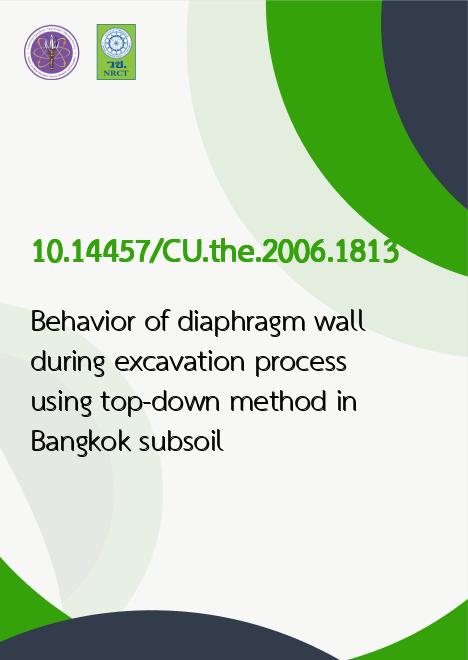
|
Behavior of diaphragm wall during excavation process using top-down method in Bangkok subsoil |
|---|---|
| รหัสดีโอไอ | |
| Title | Behavior of diaphragm wall during excavation process using top-down method in Bangkok subsoil |
| Creator | Nghia Trong Le |
| Contributor | Wanchai Teparaksa, Mitachi, Toshiyuki |
| Publisher | Chulalongkorn University |
| Publication Year | 2549 |
| Keyword | Diaphragm walls, Excavation, Soils -- Thailand -- Bangkok, Soil consolidation |
| Abstract | The simple linear elastic-perfectly plastic model with soil parameters s[subscript u], E[subscript u] and v of undrained condition is usually applied to predict the displacement of constructed diaphragm wall (DW) on soft soil during excavation. However, that could not explain the continuous increment of lateral displacement of DW for the large and deep excavation area both during the elapsed time without activity of excavation and after finishing excavation. To study the characteristic behaviors of soil behind the DW during those periods, a series of test on Bangkok soft clay samples was simulated in the same manner as stress condition of soil element happening behind diaphragm wall using triaxial tests. Three kinds of triaxial tests were carried out in this research: K[subscript 0] consolidated undrained compression (CK[subscript 0]UC) and K[subscript 0] consolidated drained/undrained unloading compression with periodic decrement of horizontal pressure (CK[subscript 0]DUC and CK[subscript 0]UUC). The study yields the findings namely the shear strength of series CK[subscript 0]DUC tests is equal to the residual strength of CK[subscript 0]UC tests. The Young’s modulus determined at each decrement step of the horizontal pressure of soil specimen on CK[subscript 0]DUC tests decreases with an increase in deviator stress. The decrement of Young’s modulus (E) with strain level was observed on CK[subscript 0]UC, CK[subscript 0]DUC and CK[subscript 0]UUC tests. The lower bound E values are equal to 46%, 50% and 60% of initial Young’s modulus (E[subscript 0]) on the CK0UC, CK0DUC and CK0UUC tests, respectively. Besides, the slope of Critical State Line of both CK[subscript 0]UC and CK[subscript 0]DUC tests has the same value of 1.5. Moreover, the axial and radial strain rates of each decrement of horizontal pressure step of CK[subscript 0]DUC tests are established with the function of time, slope of critical state line and ratio of deviator and mean effective stress. The test results are beneficial to the prediction of the diaphragm wall deflection during excavation. The 2D-FE analysis for a case study, Bank of Thailand project, was carried out with elastic-perfectly plastic (EPP) and Soft Soil Creep (SSC) models using PLAXIS program. The EPP soil model was applied to predict effectually the lateral displacement of DW on excavation time and elapsed time by the estimated Young’s modulus corresponding to strain level. For the SSC model, the horizontal coefficient of deformation (C[subscript ar]) which could be applied for FE analysis to predict the lateral displacement of DW versus time should be studied further. |
| URL Website | cuir.car.chula.ac.th |